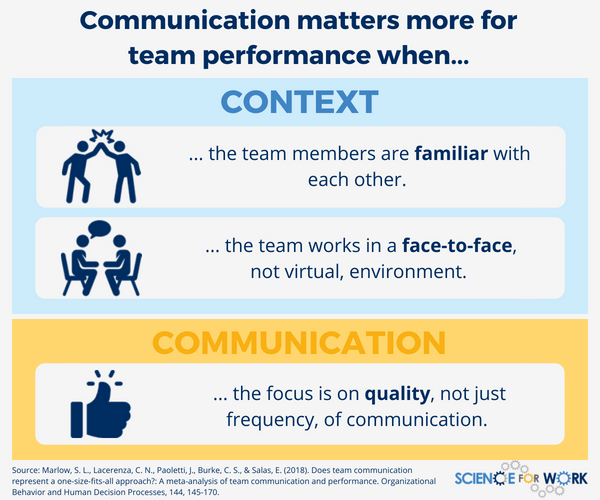Effective communication can benefit any high-performing team out there. Team members who communicate well can help build team trust. It can also get the entire team to collaborate and work on one common goal. However, most teams struggle with communication issues. This can negatively impact productivity, morale, and results. This guide will help you learn more on how to improve team communication effectively.
Establish Clear Guidelines Around Communication
Make sure everyone understands the appropriate communication channels and norms about things like response time. You may want to have a rule that emails get answered within 24 hours or decide how quickly someone should reply to a team chat. Spell out event communication etiquette like when it’s acceptable to be late to meetings or how to give presentation feedback. This avoids potential conflict and misaligned expectations.

Listen Actively
Improving communication is not just about better speaking but also better listening. Provide your full attention when team members are talking and don’t interrupt. Maintain eye contact, ask thoughtful follow-up questions, reflect back key points, and restate what you heard to show you understand. This makes people feel truly heard, promoting further openness and honesty in conversations.
Give Regular Feedback
Anyone learning how to improve communication in a team should implement a proper feedback sharing mechanism. Consistent, compassionate feedback, both positive and developmental, is essential for growth. Praise contributions that energize and inspire the team. Identify potential skills members could build that would help their role. Frame developmental tips constructively by emphasizing growth, not failure. Schedule monthly or quarterly 1-on-1s to discuss progress and goals to ensure quality feedback.
Address Issues Quickly
Left unresolved, even minor issues or misunderstandings can escalate into major conflicts. When communication problems do crop up, avoid pointing fingers or assigning blame. Simply state the problem and invite others to suggest solutions. If a conflict emerges, direct the discussion to understanding all perspectives. This constructive approach prevents defensive reactions while enabling everyone’s views to be heard so you can find common ground.
Limit Multitasking
It’s difficult to communicate effectively while distracted. Discourage team members from checking emails or texting during meetings which signals that the speaker does not have someone’s full attention. Likewise, when others are speaking, avoid distractions yourself. Multitasking divides focus whereas communication requires true presence. Close laptop lids, set phones facedown, and focus wholeheartedly on the conversation.
Use Videoconferencing When Possible
Emails, chat apps, phone calls, and text messages are convenient remote communication channels. However, they lack the facial expressions, body language, and tone of voice that convey nuance, empathy, and meaning. Where feasible, choose video conferencing over other remote mediums as it more closely mimics in-person interactions, supporting stronger bonds and understanding between team members.

Clarify Decision-Making Authority
Confusion around decision-making power can hamper progress. Make it clear who has final sign-off on which kinds of decisions. If a project lead has autonomy over how they accomplish tasks while you simply weigh in on budget decisions, spell that out. If you expect to give final approval on all external communications, state that expectation upfront. Establish clear lanes of authority so people know when they can make independent calls versus needing your say-so before moving ahead.
Train as a United Front
Strong team relationships extend beyond work projects—teams are most united when they feel a sense of camaraderie. Make communication training fun by doing improv workshops or engaging outdoor adventures together. Escape rooms require listening closely and solving problems as a collective. Even sharing meals offers a chance to connect on a personal level through storytelling and laughter that ultimately strengthens work relationships as well.
Serve as Chief Diplomat
Leaders often bridge different perspectives between team members. Make communication across factions your responsibility instead of expecting members to work out differences themselves. Listen openly to divergent views. Identify common interests. Offer compromises. Handle tension with empathy, never escalating things. Serving as lead diplomat builds connections across your team so communication flows more smoothly.
Assign a ‘Devil’s Advocate’ Role
While you want to build team cohesion, too much unity can lead to narrow thinking or group thinking. Assign someone to serve as “devil’s advocate” to encourage alternate viewpoints and constructive debate. Make it a rotating role so different people expand thinking. Ensure there are no hard feelings after dissenting—it’s about exploring new angles, not a sign of disloyalty. Welcoming respectful dissent through a devil’s advocate implants broader input into communication.
Avoid Email-Only Threads for Complex Matters
Reading tone into email is impossible, opening the door for misunderstanding and miscommunication when discussing anything emotionally charged or nuanced. Require team members to default to a quick phone or video call instead of lengthy email chains as soon as a complex or sensitive matter arises that requires discussion. This simple norm can save endless back-and-forth clarifying confusion and better handles conflict through the richness of real-time conversation.
Create a Digital Water Cooler
Remote employees can feel left out of the casual conversations by the water cooler that often lead to productive insights or strengthened connections. Create virtual spaces for spontaneous sharing and bonding beyond structured meetings. Have an ongoing chat room or forum focused on fun life updates, interesting articles, or creative ideas. Enable team members to lift each other up with kudos. Structured communication has its place, but informal spaces build camaraderie.
Summarize Key Decisions and Action Items at the End of Meetings
Misalignment easily happens when people leave important meetings with different understandings. Wrap up every meeting by summarizing the key decisions, action items, and next steps discussed. Send a follow-up email after meetings explicitly stating responsibilities any team members committed to so there is written documentation along with verbal discussion. This way of effective team communication helps keep the entire team’s efforts in sync.

Final Words
Following these tips can surely help you improve team communication. Strong communication is the glue that holds effective teams together—without it, expectations go unmet, relationships fray, and results suffer. As a leader, promoting open, constructive communication should be one of your top priorities. Implementing even a few of these tips can get your team to communicate better to drive greater alignment and performance.
When team members feel comfortable honestly expressing ideas and feel heard by caring colleagues committed to shared goals, tremendous synergies emerge to deliver meaningful results. So, invest deliberately in building communication skills across your team. At Leadership Circle, we are committed to providing you with the resources and products that support effective communication and leadership development.
From our books that walk leaders through advanced communication techniques to our customizable leadership training programs, we offer solutions that cater to your unique needs.
Explore our products and see how Leadership Circle can help you achieve your goals. Contact our sales team today to learn more about how we can support your journey towards exceptional team performance.





Great reminder about theBlog Comment Creation importance of setting clear communication norms—it’s amazing how much smoother collaboration becomes when expectations around timing and etiquette are clearly defined. One thing I’ve found helpful is revisiting those norms periodically as team dynamics evolve, especially when new members join or workflows shift.
Simply fantastic. You’ve dissected a complex topic in a way that is both easy to comprehend and deeply insightful. You’ve certainly gained a new subscriber and a dedicated reader today!
Great information shared.. really enjoyed reading this post thank you author for sharing this post .. appreciated
I genuinely enjoy reading posts that encourage deep thought, and this one certainly did that for me. It shifted my perspective in a positive way. Thank you for creating such a space for discussion.
Great information shared.. really enjoyed reading this post thank you author for sharing this post .. appreciated